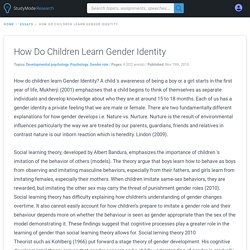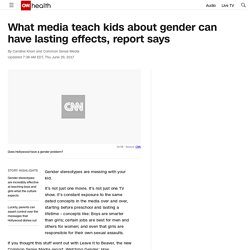

In this collection, we will share articles about other factors besides biological approach that determines gender roles and identities in children.
Resource #1: Gender Roles and Stereotypes. Resource #1: Gender Roles and Stereotypes. Resource #2: Gender Roles in Society. Resource #3: Beyond Sex: A talk about gender identity in society. Resource #2 and #3. Resource #4: What Is Bandura's Social Learning Theory? 3 Examples.
Albert Bandura’s social learning theory (SLT) suggests that we learn social behavior by observing and imitating the behavior of others.

Bandura realized that direct reinforcement alone could not account for all types of learning, so he added a social element to his theory, arguing that people learn by observing others (Nabavi, 2012). His theory is regarded as the bridge between behaviorist and cognitive learning theories, encompassing attention, memory, and motivational processes (Muro & Jeffrey, 2008) The SLT states that in response to observation, imitation, and modeling, learning can occur even without changing behavior (Bandura, 1965). Resource #4. Resource #5: How Albert Bandura's Social Learning Theory Works. Learning is a remarkably complex process that is influenced by a wide variety of factors. As most parents are probably very much aware, observation can play a critical role in determining how and what children learn.1 As the saying goes, kids are very much like sponges, soaking up the experiences they have each and every day.
Because learning is so complex, there are many different psychological theories to explain how and why people learn. A psychologist named Albert Bandura proposed a social learning theory which suggests that observation and modeling play a primary role in this process.2 Bandura's theory moves beyond behavioral theories, which suggest that all behaviors are learned through conditioning, and cognitive theories, which take into account psychological influences such as attention and memory. Resource #5. Resource #6: The Bobo Doll Experiment. Resource #6. Resource #7 :How Do Children Learn Gender Identity - 822 Words. How do children learn Gender Identity?

A child 's awareness of being a boy or a girl starts in the first year of life, Mukherji (2001) emphazises that a child begins to think of themselves as separate individuals and develop knowledge about who they are at around 15 to 18 months. Each of us has a gender identity a private feeling that we are male or female.
Resource #7. Resource #8 : Social Learning theory of sex differences. Resource #8. Resource #9 : The Influence of Peers on Children s Socialization to Gender Roles. Resource #9. Resource #10 : Helping children express gender identity. Mental health The Telethon Kids Institute 2016 Trans Pathways was a national online survey about the mental health of Australian trans young people.

It found they were at very high risk for mental health problems, self-harm and suicide, but that this can be improved by changing some of the risk factors and developing interventions. It also found services were lacking and education was desperately needed. Results included that: Resource #10. Resource #11: What media teach kids about gender can have lasting effects, report says. Story highlights Gender stereotypes are incredibly effective at teaching boys and girls what the culture expects Luckily, parents can assert control over the messages that Hollywood dishes out Gender stereotypes are messing with your kid.

Resource #11. Resource #12 : Parents Talk About Watching Gender. Resource #12.